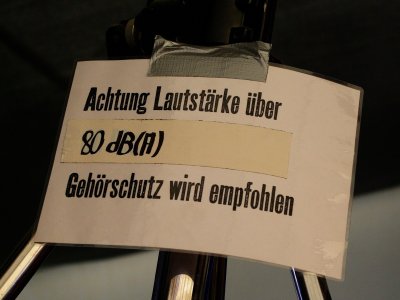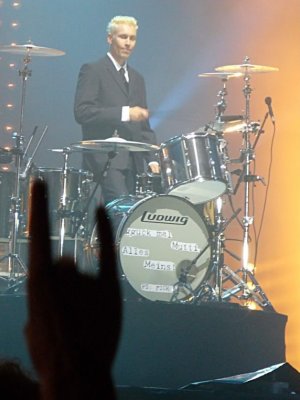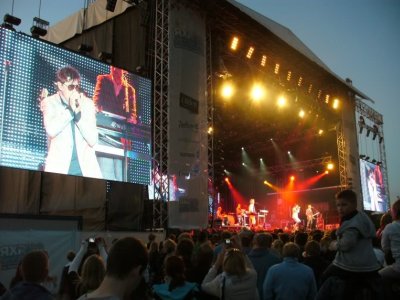11/11/11 – St. Kaizers Day, or something like that! Apart from the new album and the Spektrum DVD, the Kaizers musical “Sonny” celebrated its premiere, and I definitely couldn’t miss out on that of course… here’s my report!
Now, I’ve written so many concert reviews – but how do you write about a musical? Well, maybe I should first note that I will stick to the term “musical”, even though Kaizers keep calling it “music theatre”. But I don’t really see the difference there… =;-)
I went into the show with high expectations, but with expectations that were probably impossible NOT to fulfill. I love musicals, I love Kaizers, so nothing could go wrong here. =;-) And that’s just how it turned out: I was absolutely flashed afterwards, totally impressed and amazed! However, I was very very glad to see the play two days in a row, because after the first time, I was quite “overwhelmed”. I can’t really say how much of this was due to the language and how much to the story; unfortunately, that’s hard for me to separate. Regarding the language, I was surprised how much I actually understood – in fact I got almost everything except for a few small skirmishes and jokes, but as long as there was only one person talking, I had no problem understanding – despite (or maybe because of? *g*) the west coast dialect. And of course the songs were familiar anyway (even though I have to admit that the lyrics of the old songs are the ones I know least, since I didn’t know Norwegian back then). However, the play involved a huge number of people and characters, which you had to recognize and keep apart, and there was a lot of story to keep up with. And that, in connection with the language, was pretty hard for me; I felt a bit like this was too much to keep up with at the same time, and I was lost in the storyline a couple of times. However, I found it interesting that Janove said lateron that it would be helpful to see the play more than once to really understand it … that’s absolutely true, and the second time I was able to fill in almost all of the “holes”, but that’s not really the sense of a theater play, right?! But then I can imagine that a Norwegian native doesn’t have the problems that I had, and that usually, it should be possible to understand the story the first time around. I guess I had a little disadvantage after all, language-wise… =;-)
Rogalandteater is tiny – well, at least if you compare it with German musical theaters. *g* I guess that it takes about 400 people. Of course there were lots of celebrities in the audience during the premiere, and probably a more “typical” theater audience. On the second day, the audience was noticeably younger. The stage was impressive – despite the very simple set design, with two stair structures that were used in different ways and various stage props. And in relation to the rather small auditorium, the stage seemed absolutely gigantic!
Also regarding the music, “impressive” is probably the word that fits best. Some of the Kaizers songs were hardly changed at all and just sung by the actors, others were very different from the original version. And many left a huge impression simply because of the amount of people on stage and because the context was so bombastic. Phenomenal! Wow! So you’ve heard the songs a hundred times, and suddenly they hit you again, as if they were all new … =:-) I was especially impressed by the versions of Bak et Halleluja and Ompa til du dør, which fit so perfectly into the mood of the play, and which were just absolutely impressive. And also Rullett, Dieter Meyers, Evig pint, and especially Drøm hardt were simply brilliant.
The actors are no trained musical singer, and this showed a little sometimes. But in general, this wasn’t negative, and it didn’t really matter that you could notice some weaknesses whenever the singing parts got really difficult. Quite the opposite; each actor used his or her own way of singing the songs, and this of course is really exciting because we know the songs only in the way that Janove (or Geir) sings them. The best singers by far were Vicente and Victoria, who both sing just amazing. Vicente shone with Dieter Meyers Inst, presented alone at the piano, and with a spine-tingling version of Evig pint, while Victoria was particularly impressive in Kvite Russer. (By the way: Can we please distribute the roles the same way at concerts in the future? So that we girls get to sing “lalala” and the guys get the “Kvite Russer” part? Thank you. *g*) Unfortunately, the main character number 3, Sonny, was a letdown regarding the singing, which I thought was really really sad. =:-( His “big moments” in the play are the beginning of Maestro and Kontroll på kontinentet – and both were just bad. This is a real pity, especially since Kontroll follows just after Maestro, so that the quality drops considerably from one moment to the other. What a shame! But that might be the reason why it is called “music theater” and not “musical”. =;-)
What I was wondering most about beforehand was how the songs would fit into the story. Would they really fit in “naturally”? Or would they rather be “pushed in” wherever there was an opening to put in a song? Well, I didn’t get to a final conclusion for this question… it’s something in between. Some of the songs fit really well, some pretty good (in these cases, a name or a line was changed to make them fit – like for example in Ompa til du dør), but some also leave the impression that they don’t really fit but there’s a constructed context, as if someone wondered how these songs could be included after all. Still, these songs aren’t out of place, they just don’t fit in naturally. A good example is probably the side story around Fader Martin and Fru Conrades – the two sing Bris and Di grind together, but both songs don’t contribute anything to the story. So it feels a bit as if the songs were put in to stretch the play and to give the main actors a little break. But I have to say here that this might just be my personal view – I know the songs very well, and therefore I interpret them in a certain way; perhaps you can understand them differently as well, so that they fit better into the context and contribute something to the story. So here we are back at the language problem. =;-)
So, let’s get to the story now. Here’s a clear SPOILER WARNING! If you want to see the play yourself and you want to be surprised, don’t read on … =;-)
About the story: The character that leads through the entire play is Lucifer. She acts as a kind of “storyteller”, but she’s also the one who transports death. She’s in the background of almost every scene.
Vicente, Victoria, and Sonny grow up together during the war, and they are part of the resistance movement Resistansen. Vicente (the leader of Resistansen) and Sonny become blood brothers, Vicente and Victoria are a couple, but Sonny loves Victoria as well – Victoria, however, can marry only one of the two of course, and that will be Vicente. Sonny manages to arrange a meeting with Resistansen’s biggest nemesis Monsieur Clavier. Vicente takes on the job to meet Monsieur Clavier, under the alias “Tony Fusciante”, and to dispose of him. However, “someone” rats on him and his gun is not loaded, so Clavier can overwhelm and capture him. Before Clavier does that, however, he forces Vicente to play a round of Russian Roulette, while he himself sings Rullett – in French! Absolutely brilliant. From now on, I always want this song in French. *g*
Victoria and Sonny return to Resistansen with the bad news that Vicente didn’t make it and is dead, and Sonny follows Vicente as leader of Resistansen. After years of torture at the hands of Monsieur Clavier (or rather his German torturer – “Ve know who you arr” – hilariously funny!), Vicente, who didn’t rat on Resistansen, is rescued by Monello. Monello tells him that Resistansen is going down, that Sonny took over everything (including Victoria) and that Vicente has a son who is raised by Sonny. Monello is shot on the run, and Vicente must cope on his own in a world that has changed. Nobody can tell him where to find Resistansen, and a “Dieter Meyer” has taken control. It turns out that this Dieter Meyer, also known as Maestro or Papa, is Sonny, who teamed up with Monsieur Clavier to form a huge mafia organization. So basically: Sonny, Dieter Meyer, Maestro, and Papa are all the same person! And Sonny is the “bad guy”! =:-o Helge’s comment after the play, when I, totally confused, stuttered something like “what, where, how – Sonny is the bad guy, what the hell…?” (Did I mention that I felt quite overwhelmed and didn’t really want to give any opinion about the play right afterwards, but instead think through it all again before I make up my mind, when suddenly Helge stood there and wanted to know what I thought? *g*): “Well, I knew that, of course.” Oh really? *g* Doesn’t really help me though, ’cause I have a solidarity problem here. Damn, I LIKED Sonny!!! *lol*
Anyway, back to the play. So we have the mafia organization Dieter Meyers Inst. with its leader Maestro/Sonny, who is also raising Vicente’s son Camille. Victoria still loves Vicente, but she’s married to Sonny and has to do what he wants. Vicente puts a good face on things, acts as if the past was forgiven and forgotten, and apparently joins forces with Sonny again. Sonny, in turn, remains suspicious (and righteously so) and repeatedly proves how mercilessly he steers his organization. For he is the Maestro! He divides the population into those who are submissively at his side and the “waste”, which ends up in the clutches of Dr. Mowinckel. Maybe the best scene of the play: Vicente gets an impression of the suffering of the “waste”, while they are singing Drøm hardt. Absolutely captivating and impressive! And right after that, Dr. Mowinckel comes on stage, funnily humming the Drøm hardt chorus, and stands in front of one of the “zombies” (yes, zombies, in the theater! *yeah*) that he has created and says “Eg har et spøkelse på min rygg”. *rofl*
In the end, there’s the showdown between Sonny and Vicente, because Sonny is demanding unconditional allegiance. He aims the gun at Vicente, a gunshot rings out – and Sonny falls dead to the ground. Not he has pulled the trigger, but Vicente’s son Camille. Vicente, Victoria and Camille are free, and at then end of the play, they all sing “Sonny” – but I have to say that this was something I couldn’t place at all. This is the perfect song to conclude, of course … but they just shot the bad guy, and suddenly he’s the good old blood brother again? This left me completely confused the first time; the second time I found it a bit more acceptable – as a sort of “completion”; this is how it once was, and now things are different. Still… quite confusing.
So well – I said there was “a lot of story”, didn’t I? =;-) That’s really the only criticism I have. There’s so much happening that you must be “on guard” every second to avoid being left behind. And I must confess, for me there are still a few small question marks left in the story … but I’ll still have the chance next weekend to fill in the “holes”. =;-)
And all in all I can only say: Awesome! Amazing! Fantastic! A completely new experience. And yet, totally “Kaizers”. So if you have the chance to watch this – definitely do so! And even if you don’t know Norwegian: It’s worth a visit just for the new versions of the songs already – not even mentioning the fact that a musical is always amazing and impressive, no matter if you can understand or not. =:-)
Yay, I want to see it again! And I definitely wouldn’t mind a second play, like Kaizers and Tore Renberg are hinting at already … *g*
Tags: Kaizers Orchestra, Norway, Review, Sonny, Stavanger








 DE
DE